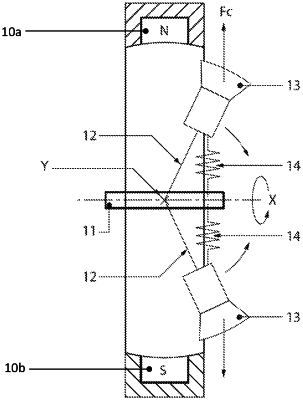| CPC H02K 49/046 (2013.01) [A62B 1/08 (2013.01); B60L 7/28 (2013.01); F16D 59/02 (2013.01); H02K 7/116 (2013.01); H02K 7/12 (2013.01); A63B 69/0048 (2013.01); F16D 2121/20 (2013.01); Y02T 10/64 (2013.01)] | 12 Claims |

|
1. An eddy current brake, comprising:
a shaft with a first rotation axis; and
two opposed electrical conductor members, each electrical conductor member being linked to the shaft via a respective link and a respective spring, the electrical conductor members, links and springs rotating with the shaft about the first rotation axis when the shaft rotates about the first rotation axis;
wherein the electrical conductor members interact with an adjacent magnetic field and, when relative movement between the electrical conductor members and magnetic field occurs, eddy current drag forces are induced slowing relative movement between the electrical conductor members and magnetic field;
wherein a respective attachment point of each link to the shaft defines a second rotation axis for each respective link, wherein the second rotation axis is not parallel to the first rotation axis;
wherein, when no shaft rotation about the first rotation axis occurs, each of the electrical conductor members is biased by the respective spring to rotate about the respective second rotation axis away from the magnetic field, and, when shaft rotation about the first rotation axis occurs, each of the electrical conductor members is urged by centrifugal forces to rotate about the respective second rotation axis against the bias of the respective spring toward the magnetic field thereby causing an eddy current brake force to be induced.
|